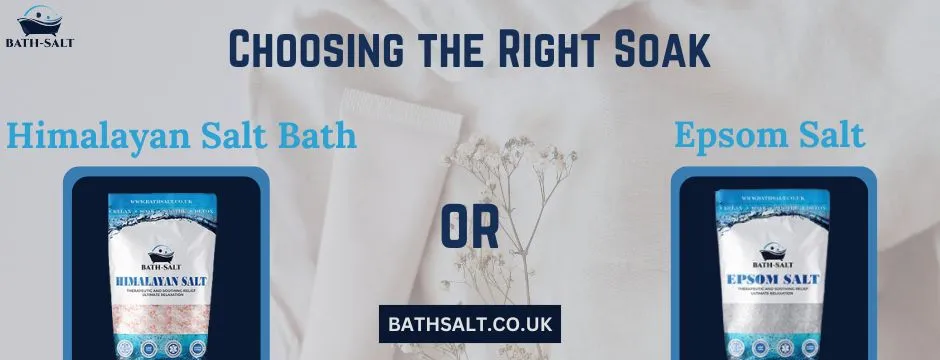No products in the cart.

Have you ever thought about what makes a bath so relaxing? If not, then allow us to introduce you to the transformative powers of Himalayan bath salt and Epsom salts. These natural treasures aren’t just going to enhance the elegance of your bath, but they hold incredible potential to soothe your muscles, refresh your senses, and restore your overall well-being. From Himalayan salt’s skin-nourishing minerals to Epsom salt’s muscle-relaxing and detoxifying properties, these natural bath salts can take your self-care routine to the next level. Let’s reveal one by one the remarkable benefits and uses of these luxury bath salts for your mind, body, and soul.
Difference between Epsom salt and Himalayan salt
The Himalayan and Epsom salts have a different appearance. Himalayan salt, a product of ancient sea evaporation, is mined in massive blocks and contains 84 trace minerals, giving it its renowned pink and orange colour.
On the other hand, Epsom salt is not truly a salt. It is a mineral compound commonly known as magnesium sulfate heptahydrate. It is produced through water distillation and contains a higher amount of magnesium than Himalayan salt. Its crystal-white appearance resembles table salt crystals.
Benefits of Epsom and Himalayan salt
Natural bath salts are highly versatile, offering countless enjoyable applications. Explore some of the most thrilling and pleasurable ways to utilise them!
1)Enhancing Your Bath Experience:
Turn your bath into a soothing retreat by adding bath salts, providing relaxation and renewal following a busy day. The dissolved salt in warm water offers muscle relief and body purification, enhanced by the pleasing scents of essential oils.
2)Refreshing your Showers:
If you want a refreshing cleanse, then choose a shower infused with dead sea bath salts by mixing them with body wash. Additionally, you can also sprinkle bath salts on the shower floor to enjoy their refreshing scent, it will enhance your bathing experience with a delightful aroma.
3)Pampering Your Feet:
Indulge yourself in a revitalising foot soak if you want to show love and care for your feet. Dissolve luxury bath bombs of natural bath salts in warm water, offering relief to tired feet and promoting circulation. Elevate the experience with the addition of essential oils for added relaxation.
4)Benefits of Exfoliation:
Use bath salts as a natural scrub by mixing them with almond or coconut oil, gently massaging onto the skin to remove dead cells and reveal a healthy glow. Consider alternative options for facial exfoliation to maintain radiant skin.
Uses of Epsom salt and Himalayan salt
Himalayan Salt:
- Decorative Himalayan salt blocks and lamps enhance ambience and serve as air purifiers.
- It’s a beneficial food additive, elevating flavours and offering health benefits.
- Salt licks for animals aid in bone, teeth, and muscle strength.
- Himalayan bath salt relaxes tired muscles, while scrubs rejuvenate skin and restore minerals.
- Used in respiratory treatments and as cooking/serving platters, keeping food warm or cold longer.
- Himalayan salt lemon water replenishes lost minerals and boosts energy.
Epsom Salt:
- Submerging feet in warm water with Epsom salt to relieve athlete’s feet.
- Mixing Epsom salt with water can aid in the treatment of splinters.
- Cure fungus-infected toenails by soaking in an Epsom salt solution.
- Detoxify and relax with warm water and Epsom salt baths, enhanced with shower bath bombs for sprains and bruises.
- Use as a laxative for constipation relief.
- Exfoliate skin with a scrub of Epsom salt and olive oil.
- Combine with a face cleanser to remove dead cells.
- Remove blackheads with a mixture of Epsom salt and iodine in boiling water.
- Dip feet in warm water and Epsom salt to combat foot odour and soothe achy feet.
- Boost volume by mixing Epsom salt with hair conditioner.
Instructions for Using Himalayan Bath Salts:
Preparing a salt bath is simple with our luxurious gift sets. Before starting, it’s advisable to take a quick shower to eliminate any residual dirt from your skin, ensuring optimal hydration. Place a water bottle near you to maintain hydration and aid in toxin removal. Once ready, follow these steps:
1)Fill your bathtub with comfortably warm water, avoiding scorching temperatures.
2)Add the Himalayan salt to the water following the guidance outlined on the packaging. Ensure thorough mixing for effective dissolution.
3)Submerge yourself in the tub and soak for 10-30 minutes.
4)Rinse off the Himalayan salt, gently pat your skin dry, and apply moisturiser to provide hydration.
Which salt is best for bathing and exfoliating?
The best salt for bathing and exfoliating depends on your specific skin concerns and preferences. If you’re looking for a mineral-rich exfoliant with skin-nourishing properties, Himalayan salt may be the preferred choice. It helps to remove dead skin cells, unclog pores, and promote skin renewal. However, if muscle relaxation and detoxification are your main priorities, Epsom salt could be more suitable. As an exfoliant, it can help soften rough skin, improve circulation, and promote relaxation.
Final words
If you incorporate these salts into your daily bath routine, they will definitely revolutionise your well-being. For your every need, these salts have solutions. It is good to have comprehensive knowledge of Himalayan bath salts and Epsom salts so that you can utilise them effectively. Let’s get out with Bath Salt from fatigue days and unslept nights and shower ourselves with the love of luxury bath bombs.
Believe us! They will take you to another world.
